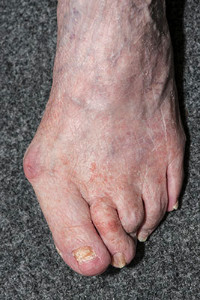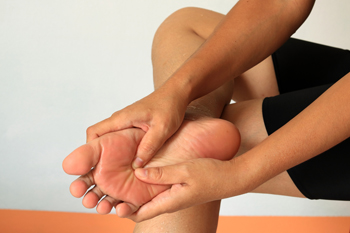
 A bunion is considered to be a bone disorder that can gradually get worse. It appears as a bony protrusion on the side of the big toe, and larger shoes may need to be worn that can accommodate the growing bunion. It generally develops as a result of genetic factors, or from wearing shoes that do not have adequate room for the toes to move freely in. Additionally, existing medical conditions including flat feet and specific types of arthritis, may contribute to the development of a bunion. In severe cases, calluses may form on top of the bunion, and friction may cause this to happen. Some of the symptoms that are associated with this condition may include a numbing or burning sensation, and it may be difficult to move the affected toe. If you have signs of a bunion, it is suggested that you consult with a podiatrist who can guide you toward the correct treatment options.
A bunion is considered to be a bone disorder that can gradually get worse. It appears as a bony protrusion on the side of the big toe, and larger shoes may need to be worn that can accommodate the growing bunion. It generally develops as a result of genetic factors, or from wearing shoes that do not have adequate room for the toes to move freely in. Additionally, existing medical conditions including flat feet and specific types of arthritis, may contribute to the development of a bunion. In severe cases, calluses may form on top of the bunion, and friction may cause this to happen. Some of the symptoms that are associated with this condition may include a numbing or burning sensation, and it may be difficult to move the affected toe. If you have signs of a bunion, it is suggested that you consult with a podiatrist who can guide you toward the correct treatment options.
If you are suffering from bunion pain, contact Dr. Bert Altmanshofer of Pennsylvania. Our doctor can provide the care you need to keep you pain-free and on your feet.
What Is a Bunion?
Bunions are painful bony bumps that usually develop on the inside of the foot at the joint of the big toe. As the deformity increases over time, it may become painful to walk and wear shoes. Women are more likely to exacerbate existing bunions since they often wear tight, narrow shoes that shift their toes together. Bunion pain can be relieved by wearing wider shoes with enough room for the toes.
Causes
Symptoms
In order to diagnose your bunion, your podiatrist may ask about your medical history, symptoms, and general health. Your doctor might also order an x-ray to take a closer look at your feet. Nonsurgical treatment options include orthotics, padding, icing, changes in footwear, and medication. If nonsurgical treatments don’t alleviate your bunion pain, surgery may be necessary.
If you have any questions, please feel free to contact our office located in Duncansville, PA. We offer the newest diagnostic and treatment technologies for all your foot care needs.
Read more about Bunions As your child's feet become stronger, it is important that the correct size shoes and socks are worn while walking outside. Research has indicated the importance of having your child's feet measured approximately every three months, as this can be helpful in determining the correct shoe size. The feet will typically become stronger while walking barefoot indoors, which can be a result of the toes grasping the floor. Many babies are born with flat feet, however the arch generally will develop during the teenage years. Additionally, it is common for many children to walk on their tip-toes, which can be indicative of an existing foot issue. If you would like more information about how to properly care for your child’s feet, please consult with a podiatrist.
As your child's feet become stronger, it is important that the correct size shoes and socks are worn while walking outside. Research has indicated the importance of having your child's feet measured approximately every three months, as this can be helpful in determining the correct shoe size. The feet will typically become stronger while walking barefoot indoors, which can be a result of the toes grasping the floor. Many babies are born with flat feet, however the arch generally will develop during the teenage years. Additionally, it is common for many children to walk on their tip-toes, which can be indicative of an existing foot issue. If you would like more information about how to properly care for your child’s feet, please consult with a podiatrist.
Making sure that your children maintain good foot health is very important as they grow. If you have any questions, contact Dr. Bert Altmanshofer of Pennsylvania. Our doctor can provide the care you need to keep you pain-free and on your feet.
Keeping Children's Feet Healthy
Having healthy feet during childhood can help prevent medical problems later in life, namely in the back and legs. As children grow, their feet require different types of care. Here are some things to consider...
Although babies do not walk yet, it is still very important to take care of their feet.
Avoid putting tight shoes or socks on his or her feet.
Allow the baby to stretch and kick his or her feet to feel comfortable.
As a toddler, kids are now on the move and begin to develop differently. At this age, toddlers are getting a feel for walking, so don’t be alarmed if your toddler is unsteady or ‘walks funny’.
As your child gets older, it is important to teach them how to take care of their feet.
Show them proper hygiene to prevent infections such as fungus.
Be watchful for any pain or injury.
Have all injuries checked by a doctor as soon as possible.
Comfortable, protective shoes should always be worn, especially at play.
If you have any questions please feel free to contact our office located in Duncansville, PA. We offer the newest diagnostic and treatment technologies for all your foot and ankle needs.
Read more about What to Do to Keep Your Child’s Feet Healthy Pain that is felt in the ball of the foot is most commonly associated with a condition known as Morton’s neuroma. Morton’s neuroma typically develops when a nerve becomes inflamed behind the third and fourth toes. Common symptoms of this condition may include pain, swelling, numbness, tingling or burning, and feeling like you’re walking on a rolled-up sock. To help alleviate discomfort, it’s recommended to rest the feet as often as possible, ice the affected area, and elevate and compress the feet as well. Custom orthotics, along with the use of anti-inflammatory medications, have also been found helpful in reducing pain. However, for more severe cases, surgery may be the best option. This is known as Morton's neurectomy. According to a recent study at Nottingham University Hospital in England, 82% of people who underwent the operation reported good to excellent results. For a proper diagnosis and to determine your best treatment options, it is highly recommended that you consult with a podiatrist.
Pain that is felt in the ball of the foot is most commonly associated with a condition known as Morton’s neuroma. Morton’s neuroma typically develops when a nerve becomes inflamed behind the third and fourth toes. Common symptoms of this condition may include pain, swelling, numbness, tingling or burning, and feeling like you’re walking on a rolled-up sock. To help alleviate discomfort, it’s recommended to rest the feet as often as possible, ice the affected area, and elevate and compress the feet as well. Custom orthotics, along with the use of anti-inflammatory medications, have also been found helpful in reducing pain. However, for more severe cases, surgery may be the best option. This is known as Morton's neurectomy. According to a recent study at Nottingham University Hospital in England, 82% of people who underwent the operation reported good to excellent results. For a proper diagnosis and to determine your best treatment options, it is highly recommended that you consult with a podiatrist.
Morton’s neuroma is a very uncomfortable condition to live with. If you think you have Morton’s neuroma, contact Dr. Bert Altmanshofer of Pennsylvania. Our doctor will attend to all of your foot and ankle needs and answer any of your related questions.
Morton’s Neuroma
Morton's neuroma is a painful foot condition that commonly affects the areas between the second and third or third and fourth toe, although other areas of the foot are also susceptible. Morton’s neuroma is caused by an inflamed nerve in the foot that is being squeezed and aggravated by surrounding bones.
What Increases the Chances of Having Morton’s Neuroma?
Morton’s neuroma is a very treatable condition. Orthotics and shoe inserts can often be used to alleviate the pain on the forefront of the feet. In more severe cases, corticosteroids can also be prescribed. In order to figure out the best treatment for your neuroma, it’s recommended to seek the care of a podiatrist who can diagnose your condition and provide different treatment options.
If you have any questions, please feel free to contact our office located in Duncansville, PA. We offer the newest diagnostic and treatment technologies for all your foot care needs.
Read more about What is Morton's Neuroma? Physicians who treat foot conditions and disorders are referred to as Doctors of Podiatric Medicine (DPM), also commonly known as podiatrists. Their role in the medical field can be vital in determining certain maladies in the body. This can be a result of symptoms that present themselves in the feet. There are several foot conditions that podiatrists are capable of treating. These can include structural deformities such as hammertoe and bunions, in addition to foot wounds, flat feet, and ingrown toenails. People who are interested in pursuing a career in podiatry must complete two years of residency following a bachelor's degree. The residency programs teach the interns medical and surgical procedures, in addition to training in foot surgery. If you are interested in pursuing a career in podiatry, it is strongly advised that you speak with a podiatrist who can help you to determine if this is the right field for you.
Physicians who treat foot conditions and disorders are referred to as Doctors of Podiatric Medicine (DPM), also commonly known as podiatrists. Their role in the medical field can be vital in determining certain maladies in the body. This can be a result of symptoms that present themselves in the feet. There are several foot conditions that podiatrists are capable of treating. These can include structural deformities such as hammertoe and bunions, in addition to foot wounds, flat feet, and ingrown toenails. People who are interested in pursuing a career in podiatry must complete two years of residency following a bachelor's degree. The residency programs teach the interns medical and surgical procedures, in addition to training in foot surgery. If you are interested in pursuing a career in podiatry, it is strongly advised that you speak with a podiatrist who can help you to determine if this is the right field for you.
If you are experiencing pain in the feet or ankles, don’t join the stubborn majority refusing treatment. Feel free to contact Dr. Bert Altmanshofer from Pennsylvania. Our doctor can provide the care you need to keep you pain-free and on your feet.
What Is a Podiatrist?
Someone would seek the care of a podiatrist if they have suffered a foot injury or have common foot ailments such as heal spurs, bunions, arch problems, deformities, ingrown toenails, corns, foot and ankle problems, etc.
Podiatric Treatment
A podiatrist will treat the problematic areas of the feet, ankle or lower leg by prescribing the following:
A common podiatric procedure a podiatrist will use is a scanner or force plate which will allow the podiatrist to know the designs of orthotics. Patients are then told to follow a series of tasks to complete the treatment. The computer will scan the foot a see which areas show weight distribution and pressure points. The podiatrist will read the analysis and then determine which treatment plans are available.
If you have any questions please feel free to contact our office located in Duncansville, PA. We offer the newest diagnostic and treatment technologies for all your foot and ankle needs.
Read more about What is a Podiatrist?